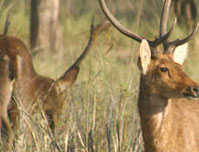Inscribed on the World Heritage List in 1988, Nanda Devi National Park
is located in Chamoli district, within the Garhwal Himalayas of Uttarakhand
state. The park extends from the latitude 30°24' in the North to the
longitude 79°53' in the East. Spread over an area of 630sq.km, the
park was established in 1980 and declared a National Park in1982. The
park is dominated by the Peak Nanda Devi (second highest peak in India
) which rises to over 7,800 m. Other peaks around the park are Trishul,
Dunagiri, Bethartoli etc.
Though the park was notified only in 1980, it has a long
history. W.W. Garden was the first person to be here in 1883. But it was
the visit of Bill Tilman and Eric Shipton, the two British  Mountaineers
who made a successful attempt on Nandadevi in 1936, which made it more
famous. Slowly, more and more expeditions and treks began to be conducted
here and by 1950 onwards large number of tourists frequenting this place
affected its pristine nature. Nanda Devi National Park was set up in 1982
and access to Trekkers was banned to protect its bio-diversity but now
parts of the park have been opened to the tourists. Garhwal Mandal
Vikas Nigam, a government of Uttarakhand enterprise, have a full fledged
mountaineering and trekking division based at Muni-ki-reti, Rishikesh,
which conducts Tours/Treks in the Garhwal Himalayas. Trekkers can contact
them for details. The richness of the biosphere makes the park extremely
special. Nanda Devi also offers some of the most picturesque views and
that's what makes it a World heritage site preserved by the UNESCO. Mountaineers
who made a successful attempt on Nandadevi in 1936, which made it more
famous. Slowly, more and more expeditions and treks began to be conducted
here and by 1950 onwards large number of tourists frequenting this place
affected its pristine nature. Nanda Devi National Park was set up in 1982
and access to Trekkers was banned to protect its bio-diversity but now
parts of the park have been opened to the tourists. Garhwal Mandal
Vikas Nigam, a government of Uttarakhand enterprise, have a full fledged
mountaineering and trekking division based at Muni-ki-reti, Rishikesh,
which conducts Tours/Treks in the Garhwal Himalayas. Trekkers can contact
them for details. The richness of the biosphere makes the park extremely
special. Nanda Devi also offers some of the most picturesque views and
that's what makes it a World heritage site preserved by the UNESCO.
The park with its altitude ranging between 2,400 mts. and
6,817 mts has some of the most unique high altitude flora and fauna
in the world. Total of 773 plants have been reported from the biosphere
reserve. Some 620 species were recorded by the 1993 Nanda Devi Scientific
and Ecological Expedition. Some of the species are considered rare.
The forests hosts fir, birch, Rhododendron and juniper, Birch etc. Apart
from these, Nardostachys grandiflora , Picroehiza kurrooa, Cypripedium
elegans, C. himalaicum, Dioscorea deltoidea and Allium stracheyi, nationally
threatened species are also found in Nanda Devi. There are some
areas within the park, where there is absolutely no vegetation.
The Fauna of the Nanda Devi National Park is also quite
interesting. It contains varied and rare kind of animal species.
83 species of animals are reported from the biosphere reserve. They
include Common Langur, Himalayan black bear, Himalayan Thar, Common
Leopard, snow leopard, Mainland Serow, bharal (Blue mountain goat),
brown bear, Goral, common langur, goral and Himalayan musk deer.
The entire Nanda Devi Biosphere Reserve
lies within the Western Himalayas Endemic Bird Area (EBA) and a total
of 114 bird species were recorded during the 1993 Nanda Devi Scientific
and Ecological Expedition. Abundant species include Grosbeak, Rose finch,
Crested Black Tit, Yellow-bellied Fantail Flycatcher, Orange-flanked
Bush Robin, Blue-fronted Redstart, Indian Tree Pipit, Vinaceous-breasted
Pipit, Nutcracker, Ruby throat etc. The park comprises of rich varieties
(around 27 species) of butterflies also. Some of them are Common Yellow
Swallowtail, Common Blue Apollo, Dark-clouded Yellow, Queen of Spain,
Indian Tortoiseshell etc.
|

